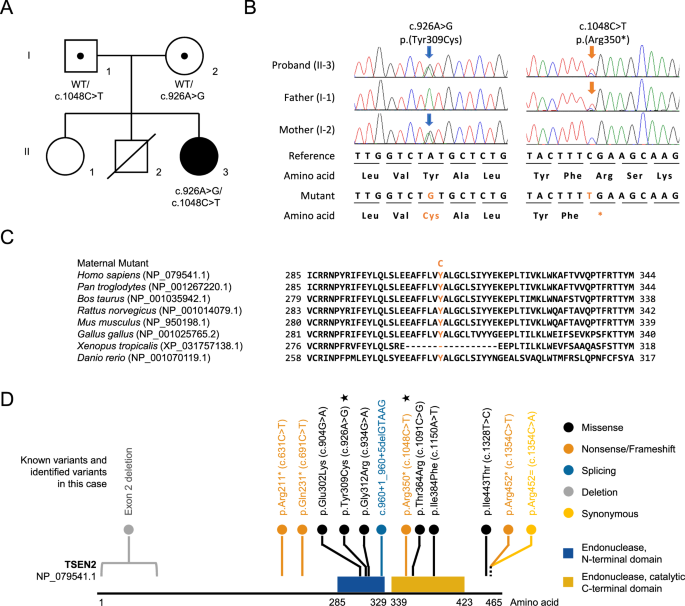Barth PG. Pontocerebellar hypoplasias. An overview of a group of inherited neurodegenerative disorders with fetal onset. Brain Dev. 1993;15:411–22.
Google Scholar
Ghasemi MR, Tehrani Fateh S, Moeinafshar A, Sadeghi H, Karimzadeh P, Mirfakhraie R, et al. Broadening the phenotype and genotype spectrum of novel mutations in pontocerebellar hypoplasia with a comprehensive molecular literature review. BMC Med Genom. 2024;17:51.
Kagermeier T, Hauser S, Sarieva K, Laugwitz L, Groeschel S, Janzarik WG, et al. Human organoid model of pontocerebellar hypoplasia 2a recapitulates brain region-specific size differences. Dis Model Mech. 2024;17:dmm050740.
Budde BS, Namavar Y, Barth PG, Poll-The BT, Nürnberg G, Becker C, et al. tRNA splicing endonuclease mutations cause pontocerebellar hypoplasia. Nat Genet. 2008;40:1113–8.
Google Scholar
Alazami AM, Patel N, Shamseldin HE, Anazi S, Al-Dosari MS, Alzahrani F, et al. Accelerating novel candidate gene discovery in neurogenetic disorders via whole-exome sequencing of prescreened multiplex consanguineous families. Cell Rep. 2015;10:148–61.
Google Scholar
Paushkin SV, Patel M, Furia BS, Peltz SW, Trotta CR. Identification of a human endonuclease complex reveals a link between tRNA splicing and pre-mRNA 3’ end formation. Cell. 2004;117:311–21.
Google Scholar
Namavar Y, Barth PG, Kasher PR, van Ruissen F, Brockmann K, Bernert G, et al. Clinical, neuroradiological and genetic findings in pontocerebellar hypoplasia. Brain. 2011;134:143–56.
Google Scholar
Bierhals T, Korenke GC, Uyanik G, Kutsche K. Pontocerebellar hypoplasia type 2 and TSEN2: review of the literature and two novel mutations. Eur J Med Genet. 2013;56:325–30.
Google Scholar
Ganapathy A, Mishra A, Soni MR, Kumar P, Sadagopan M, Kanthi AV, et al. Multi-gene testing in neurological disorders showed an improved diagnostic yield: data from over 1000 Indian patients. J Neurol. 2019;266:1919–26.
Google Scholar
Issa MY, Chechlacz Z, Stanley V, George RD, McEvoy-Venneri J, Belandres D, et al. Molecular diagnosis in recessive pediatric neurogenetic disease can help reduce disease recurrence in families. BMC Med Genom. 2020;13:68.
Google Scholar
Wang Q, Tang X, Yang K, Huo X, Zhang H, Ding K, et al. Deep phenotyping and whole-exome sequencing improved the diagnostic yield for nuclear pedigrees with neurodevelopmental disorders. Mol Genet Genom Med. 2022;10:e1918.
Cavusoglu D, Ozturk G, Turkdogan D, Kurul SH, Yis U, Komur M, et al. Evaluation of the patients with the diagnosis of pontocerebellar hypoplasia: a multicenter national study. Cerebellum. 2024;23:1950–65.
Google Scholar
Khalaf T, Al Ojaimi M, Saleh DA, Sulaiman A, Sohal AP, Khan A, et al. The utility of exome sequencing in diagnosing pediatric neurodevelopmental disorders in a highly consanguineous population. Clin Genet. 2024;106:82–89.
Google Scholar
Zhang X, Yang F, Zhan X, Bian T, Xing Z, Lu Y, et al. Structural basis of pre-tRNA intron removal by human tRNA splicing endonuclease. Mol Cell. 2023;83:1328–39.e4.
Google Scholar
Guerois R, Nielsen JE, Serrano L. Predicting changes in the stability of proteins and protein complexes: a study of more than 1000 mutations. J Mol Biol. 2002;320:369–87.
Google Scholar
Schymkowitz J, Borg J, Stricher F, Nys R, Rousseau F, Serrano L. The FoldX web server: an online force field. Nucleic Acids Res. 2005;33:W382–8.
Google Scholar
